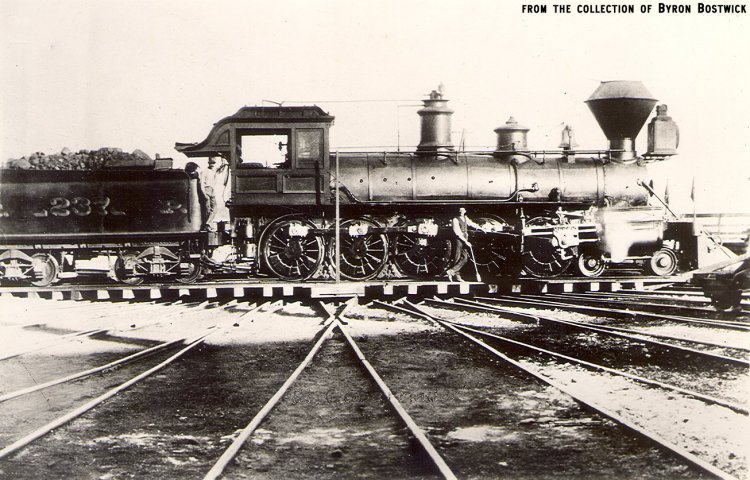- El Gobernador
Infobox Locomotive

name="El Gobernador"
powertype=Steam
gauge=RailGauge|ussg (standard gauge )
railroad=Central Pacific
builder=Central Pacific's Sacramento shops
builddate=February 1883
whytetype=4-10-0
driversize=57 in (1400 mm) diameter
cylindersize=21 in (530 mm) dia × 36 in stroke
weight=146,000 lb (66,200 kg), 154,400 lb (70,030 kg) rebuilt
weightondrivers=128,000 lb (58,100 kg), 121,600 lb (55,200 kg) rebuilt
boilerpressure=140 lbf/in²
tractiveeffort=33,150 lbf (147.5 kN)
roadnumber=237, renum. 2050 in 1891
serialnumber=21
firstrundate=March 1884
scrapdate=July 15 1894
officialname="El Gobernador""El Gobernador" was a
4-10-0 steam locomotive built byCentral Pacific Railroad at the railroad'sSacramento, California shops. It was the last of Central Pacific's locomotives to receive an official name and was also the only locomotive of this wheel arrangement to operate onUnited States rails. At the time it was built, "El Gobernador" was the largest railroad locomotive in the world. Its name is reminiscent of the railroad's first locomotive, "Gov. Stanford ", as "El Gobernador" is Spanish for "The Governor".This locomotive is sometimes mistakenly referred to as a "Mastodon" type. However, this was the unofficial name for an earlier engine, No. 229, the first4-8-0 ever built. Both engines looked nearly identical, except that "El Gobernador" was longer and had an additional pair of drivers.Construction and operation
"El Gobernador"
' s construction was completed in February 1883, amid much fanfare from the railroad, but it didn't enter service until March 1884, just over a year later. During this time, while still in Sacramento, the gigantic engine was used as an advertising tool by the railroad, to spectacular effect. According to author Guy L. Dunscomb, the engine was kept under steam near the Central Pacific's passenger depot, where it would await the arrival of passenger trains coming in from the east. As the train arrived, "El Gobernador" would steam past the depot dragging a long line of empty freight cars behind it and causing quite a stir in the process. The engine would then be decoupled and placed on adjacent trackage, where the passengers could get a good look at the monster up close.Part of the delay between construction and operation was due to the railroad's track and infrastructure of the time. It was originally designed to haul trains out of
California 'sSan Joaquin Valley viaTehachapi Loop . The locomotive was disassembled into five large subassemblies for transportation to the pass because it was thought to be too heavy for the various bridges along the route to the pass.Operationally, the locomotive didn't fare as well as was hoped due to its large cylinder size and small fire grate area (one fireman even commented disgustedly, "All Hell couldn't keep steam up in that engine!"). During initial shakedown runs around Sacramento, it was found, for example, that the engine's cylinders, which were originally built with innovative rotary valves, were not working properly. This necessitated casting an all-new set of cylinders with conventional slide valves and a Stevens valve gear.Central Pacific attempted to further remedy the problems in an 1885 rebuild which increased the locomotive's weight to 154,400 lb (70,000 kg), with 121,600 lb (55,200 kg) on the drivers. It was during this time that coal was apparently tried as a fuel in an effort to gain better steam economy. Several photographs exist of the locomotive in the Kernville yard, its tender loaded with coal instead the usual cord wood. In the railroad's 1891 renumbering plan, "El Gobernador" received road number 2050. The rebuild wasn't as successful as the railroad hoped and the locomotive was scrapped on
July 15 1894 . After dismantling, the engine's massive boiler was used to provide steam for stationary engines in the railroad shops at Sacramento well into the 20th century.Sadly, this engine appears to have largely been a victim of impatience on the part of the road's president,
Leland Stanford . A locomotive this size had never been constructed before and proved to be a unique engineering challenge. For example, the engine's frame alone was so large, that it had to be cast in two separate sections instead of all at once as with other locomotives built at Sacramento. As soon as master mechanicA.J. Stevens was able to figure out a part, Stanford would order it built and installed on the new engine, without giving any proper time for testing. Stanford also apparently kept the other members of theThe Big Four (minusMark Hopkins , who had died several years before) in the dark about the project as well. Once, while Stanford was away,Charles Crocker came through the locomotive works on a tour of inspection and saw the partially completed "El Gobernador" under construction. Having not been told about the project, he angrily demanded to know what they were up to. When told by A.J. Stevens that they were attempting to build the largest engine in the world, Crocker ordered all work stopped immediately. Meanwhile, Stanford returned to find that no new work had been done on the engine and when informed of the events that transpired, Crocker's orders were countermanded in no uncertain terms.References
*
* " [http://www.intemperance.net/carolyn/sactalk.html Southern Pacific Railway Shops] ". RetrievedJanuary 21 2006 .For further reading
*
*
*cite book| author=Dunscomb, Guy L.| title=A Century of Southern Pacific Steam Locomotives 1862 - 1962| publisher=Guy L. Dunscomb & Son| year=1963External links
* [http://espee.railfan.net/sp_steam_4-10-0.html Southern Pacific, El Gobernador 4-10-0 Steam Locomotive] - includes a side photo of the locomotive
Wikimedia Foundation. 2010.
